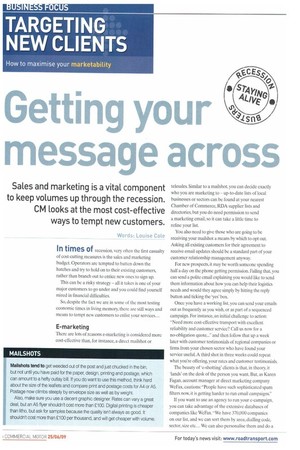Getting yoL
Page 46

Page 47

If you've noticed an error in this article please click here to report it so we can fix it.
Sales and marketing is a vital component to keep volumes up through the recession. CM looks at the most cost-effective ways to tempt new customers.
Words: Louise Cole
In times of recession, very often the first casualty of cost-cutting measures is the sales and marketing budget. Operators are tempted to batten down the hatches and try to hold on to their existing customers, rather than branch out to entice new ones to sign up.
This can be a risky strategy — all it takes is one of your major customers to go under and you could find yourself mired in financial difficulties.
So, despite the fact we are in some of the most testing economic times in living memory, there are still ways and means to tempt new customers to enlist your services...
E-marketing
There are lots of reasons e-marketing is considered more cost-effective than, for instance, a direct mailshot or telesales. Similar to a mailshot, you can decide exactly who you are marketing to — up-to-date lists of local businesses or sectors can be found at your nearest Chamber of Commerce, RDA supplier lists and directories, but you do need permission to send a marketing email, so it can take a little time to refine your list.
You also need to give those who are going to be receiving your mailshot a means by which to opt out. Asking all existing customers for their agreement to receive email updates should be a standard part of your customer relationship management anyway.
For new prospects, it may be worth someone spending half a day on the phone getting permission. Failing that, you can send a polite email explaining you would like to send them information about how you can help their logistics needs and would they agree simply by hitting the reply button and ticking the 'yes' box.
Once you have a working list, you can send your emails out as frequently as you wish, or as part of a sequenced campaign. For instance, an initial challenge to action: "Need more cost-effective transport with excellent reliability and customer service? Call us now for a no-obligation quote..." and then follow that up a week later with customer testimonials of regional companies or firms from your chosen sector who have found your service useful. A third shot in three weeks could repeat what you're offering, your rates and customer testimonials.
The beauty of 'e-shotting' clients is that, in theory, it 'lands' on the desk of the person you want. But, as Karen Fagan, account manager at direct marketing company WeFax, cautions: "People have such sophisticated spam filters now, it is getting harder to run email campaigns."
If you want to use an agency to run your e-campaign, you can take advantage of the extensive databases of companies like WeFax. "We have 370,000 companies on our list, and we can sort them by area, dialling code, sector, size etc... We can also personalise them and do a mail merge with your existing customer base," says Fagan. Email is becoming more expensive because of the cost of maintaining legal lists —WeFax charges approximately £100 per thousand emails.
E-marketing doesn't stop with introductory mailshots. You can send out newsletters, special offers, customer successes and loyalty schemes Make sure you always drive traffic to your website. This means you can be succinct in the email — people are deterred by long messages. Give them the gist and invite them to find out more.
Make sure you approach e-marketing from the customers' point of view and give them what they want to know most upfront — this will save you money, improve your service and cut your carbon footprint. Be polite, but don't fuss — -May I trouble you for a moment of your time..." means you begin by asking them for something.
Never write it and send it on the same day, or without someone else reading it first. First impressions count.
Fax marketing This is the cheapest form of marketing.WeFax, for example, can send out 10,000 faxes for just £150.1t is impossible to gauge the response rate in advance, but it's worth trying.
Adverts Magazine or local newspaper ads can work well, but you need to pinpoint your audience carefully, and even then you have no idea who has seen it and no way of following it up. Ads tend to be quite expensive, particularly since they only appear once. If you do advertise in magazines or newspapers, now is a good time to negotiate on rates, particularly if you want to place a series of ads.
Websites Your website can underpin all this marketing activity by driving traffic back for more information. Use anything you can to improve the search optimisation of your site — blogging, participating in forums and social networking sites can all be useful ways beyond the standard news and info on your site. Make sure your contact details are really obvious, and remember to include a phone number, not just a webform. •












































































































































